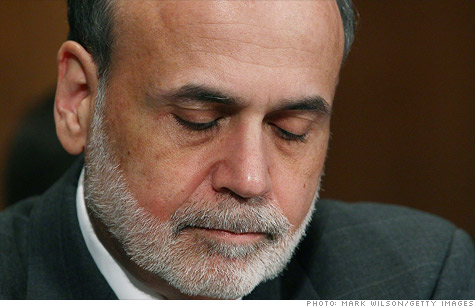Search News

NEW YORK (CNNMoney) -- The Federal Reserve painted a much gloomier picture of the economy Tuesday, and indicated it would keep cash cheap and easy for at least two more years.
Following its fifth policymaking meeting of the year, the central bank also surprised Wall Street with several dramatic changes to its official statement.
Among those surprises were dissension among the ranks of the central bank, a "considerably slower" reading on the economy, and a bold statement that the Fed stands ready to enact further stimulus measures if needed.
Interest rates: The Fed indicated it plans to keep "exceptionally low" interest rates in place until at least mid-2013 as a way to continue to prop up the recovery.
The federal funds rate is the central bank's key tool to spur the economy and a low rate is thought to encourage spending by making it cheaper to borrow money.
The Fed has kept the rate near zero since 2008, but has long been ambiguous on its future timeframe, saying it would keep the federal funds rate near zero for an "extended period."
The new two-year time horizon was an unusual move because the Fed doesn't typically signal its policies that far in advance, and because it was interpreted as an admission that the economy will remain weak until then.
"It surprised me that they boxed themselves into a corner that way," said Professor Steve Wyatt from the Farmer School of Business at Miami University. "It essentially tells markets that they don't see any hope that we will see a stronger economic recovery in the next two years."
Disagreement within the Fed: Also surprising, was that three of the Fed's 10 voting members formally dissented against using the new language. Multiple dissenting votes are rare among the Fed's policy-making committee.
Regional Fed presidents Richard Fisher of Dallas, Narayana Kocherlakota of Minneapolis and Charles Plosser of Philadelphia said they would have preferred to keep the "extended period" phrase instead of laying out the 2013 timeframe.
"What it's telling us is, this was a very divisive meeting and there was a lot of back and forth," said Sherry Cooper, chief economist with BMO Financial Group and a former Fed economist.
Aside from some other gloomier language about the U.S. recovery, the Federal Reserve did little else in response to heightened fears about a global economic slowdown.
"This was a very conservative statement," Cooper said. "Basically, they did the least they could do, short of doing absolutely nothing."
Gloomy outlook: The central bank acknowledged that economic growth in the United States is "considerably slower" than expected. That marks a change from prior statements, when the Fed had said the recovery was chugging along at a "moderate pace."
"Information received since the Federal Open Market Committee met in June indicates that economic growth so far this year has been considerably slower than the Committee had expected," the official Fed statement said.
The Fed also acknowledged that thejob market has recently deteriorated, consumer spending has flattened out and the housing sector remains depressed.
More stimulus ahead? Critics have pointed out that there's little the Fed can do to tame volatile financial markets after Standard & Poor's downgraded the country's credit rating Friday. Having exhausted most of its traditional tools, the Fed also has few remaining options to try to prop up the sluggish economy and job market, many say.
But the Fed indicated it is considering a "range of policy tools available to promote a stronger economic recovery," and "is prepared to employ these tools as appropriate." This language was much stronger than in June, when the Fed seemed to take a more passive stance, saying it would "monitor the economic outlook" and "act as needed."
In June, the Fed completed a $600 billion stimulus effort known as the second round of quantitative easing, or QE2. That policy is widely credited with supporting stocks earlier this year, but is also blamed for driving oil and gasoline prices higher -- an effect that spurred inflation and hurt U.S. consumer spending.
Some Fed members still fear that more monetary stimulus could drive inflation higher. But on the other hand, without stimulus, economists say the U.S. economy may risk falling into another recession.
At its prior meeting in June, the Federal Reserve cut its forecasts for U.S. economic growth to between 2.7% and 2.9% for the year overall. ![]()
| Overnight Avg Rate | Latest | Change | Last Week |
|---|---|---|---|
| 30 yr fixed | 3.80% | 3.88% | |
| 15 yr fixed | 3.20% | 3.23% | |
| 5/1 ARM | 3.84% | 3.88% | |
| 30 yr refi | 3.82% | 3.93% | |
| 15 yr refi | 3.20% | 3.23% |
Today's featured rates:
| Latest Report | Next Update |
|---|---|
| Home prices | Aug 28 |
| Consumer confidence | Aug 28 |
| GDP | Aug 29 |
| Manufacturing (ISM) | Sept 4 |
| Jobs | Sept 7 |
| Inflation (CPI) | Sept 14 |
| Retail sales | Sept 14 |